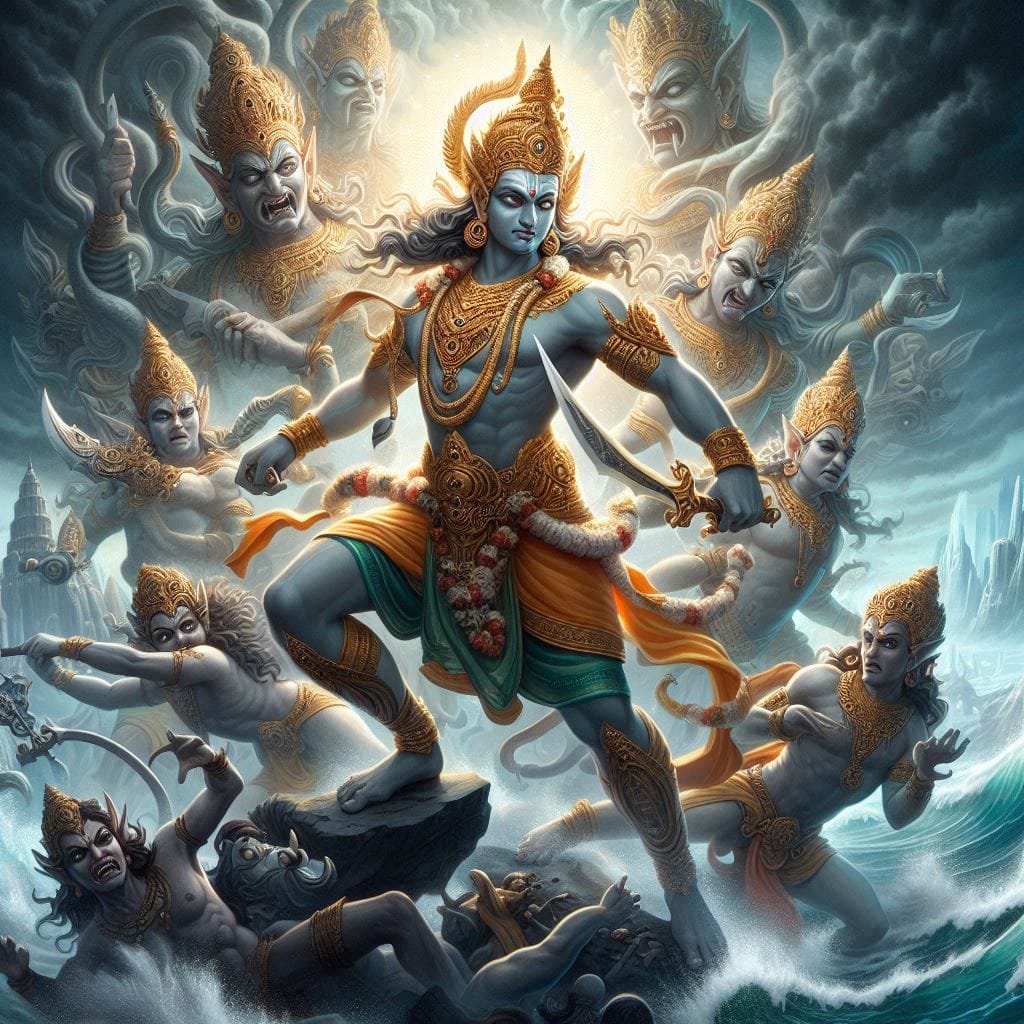Battles of Lord Indra: Demons of Rig Veda
Rig Vedic narratives detailing Indra's battles with asura entities. #Vritra, #Namuchi #Pipru #Sambara #Vala, #Dasa #Dasyu #Shushna #Arbuda #Duni Vishvarupa. #RigVeda #Indra #Mythology #Asuras #CosmicOrder #HinduMythology #occultsanctum #Demons

This post examines the mythic narratives within the Rig Veda that detail the confrontations between Lord Indra and a series of formidable asuric entities. It scrutinizes the attributes, boons, and strategic roles of these adversaries, and delineates the circumstances under which Indra’s interventions restored cosmic order. The discussion focuses on ten principal figures: Vritra, Namuchi, Pipru, Sambara, Vala, Dasa/Dasyu, Shushna, Arbuda, Duni, and Vishvarupa.
Vritra
Vritra is portrayed as a serpentine embodiment of darkness and obstruction, whose power was derived from his unyielding control over the celestial waters. Endowed with a potent boon that rendered him nearly invulnerable to conventional weapons, he enacted a regime of drought and disorder. His eventual downfall came through the decisive intervention of Indra, whose thunderbolt—the Vajra—disintegrated Vritra’s defenses, liberating the waters and re-establishing cosmic equilibrium.
Namuchi
Namuchi emerges in the corpus as a cunning and formidable asura whose intrinsic strength and divine boon made him impervious to the ordinary means of warfare. This near-indestructibility, characterized by his resistance to both “dry” and “wet” weaponry, positioned him as a critical threat to the established cosmic order. Indra’s response, marked by an ingenious tactical adaptation—employing a weapon derived from the unique properties of water foam—enabled him to overcome Namuchi’s defenses and reinstate divine supremacy.
Pipru
In the Rig Vedic narrative, Pipru is depicted as a potent and defiant adversary who marshaled significant force against the gods. His inherent resilience, augmented by a protective boon, rendered him resistant to standard attacks, thereby escalating the stakes of his confrontation with the divine order. Indra, undeterred by this formidable resistance, mobilized the full extent of his thunderous might, ultimately quelling Pipru’s insurgency with the decisive impact of his Vajra.
Sambara
Sambara’s narrative is distinguished by his construction of formidable fortresses and his protracted engagement in warfare against the celestial forces. His power was amplified by a divine boon that afforded him long-standing invulnerability, enabling him to maintain an oppressive hold over his territories for extended periods. However, the relentless pursuit by Indra—whose campaign systematically dismantled Sambara’s defenses—culminated in a conclusive victory that reasserted divine order across the realms.
Vala
Vala is conceptualized as an enigmatic asura whose disruptive influence manifested in the sequestration of sacred entities and treasures within an impenetrable cavern. This act of cosmic subversion was bolstered by a boon that rendered him nearly untouchable, thereby securing his dominion over the stolen riches. The eventual mobilization of Indra’s forces—augmented by the sagacity of the Angiras sages—precipitated a climactic assault, during which the thunderous strike of the Vajra shattered Vala’s lair and restored the abundance once sequestered.
Dasa/Dasyu
Representing a collective archetype of rebellious forces, the Dasa and Dasyu are depicted as embodiments of opposition to the Vedic pantheon. Their substantial strength and strategic use of fortifications enabled them to resist the imposition of the divine order. Nevertheless, Indra’s inexorable campaign against these entities, characterized by a series of relentless and coordinated assaults, eventually resulted in the disintegration of their defensive structures and the re-establishment of celestial dominion.
Shushna
Shushna is characterized as a menacing asura whose influence was primarily marked by the dissemination of drought and desolation. Empowered by a protective boon that rendered him largely impervious to conventional assaults, he posed a significant challenge to both divine and mortal realms. The resultant confrontation with Indra, underpinned by the latter’s formidable thunderous force, concluded with Shushna’s downfall and the subsequent restoration of life-sustaining rains.
Arbuda
Arbuda is depicted as a fearsome serpent inhabiting the mountainous precincts, where his strength enabled him to obstruct the vital flow of life-giving waters. His power, coupled with an intrinsic resilience, established him as a formidable agent of chaos and stagnation. The dramatic intervention by Indra—whose Vajra cleaved through Arbuda’s formidable defenses—resulted in the liberation of the obstructed waters, thereby alleviating the ensuing drought and restoring natural abundance.
Duni
Duni is portrayed as a dark and potent asura whose objective was to subvert the established cosmic balance. His near-impervious nature, conferred by a divine boon, rendered him a persistent threat to the integrity of the divine order. In response, Indra marshaled his full might, engaging Duni in a climactic confrontation wherein a decisive strike of the Vajra culminated in the termination of Duni’s disruptive reign and the reinstatement of equilibrium.
Vishvarupa
Vishvarupa is a multifaceted asura distinguished by his multiple heads and diverse divine capabilities. Initially aligned with the gods, his eventual betrayal—manifested in the deliberate undermining of their authority—transformed him into a significant existential threat. Each of his heads and forms was attributed distinct divine feats, rendering his overall power both formidable and complex. Indra’s ensuing response, marked by an intense and multifarious battle, resulted in the systematic severance of Vishvarupa’s multiple facets, thereby quelling his treachery and restoring cosmic order.


